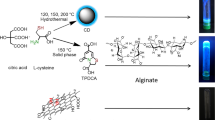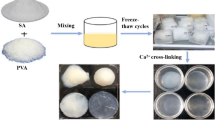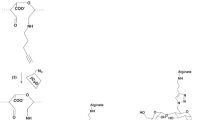Abstract
Visible light-curable alginate was prepared by coupling alginate with furfurylamine. The furan content of the alginate was investigated through Fourier transform infrared spectroscopy and proton nuclear magnetic resonance spectroscopy. The prepared furfuryl alginate (F-Alginate) underwent gelation in the presence of a photosensitizer, such as Rose Bengal or riboflavin, under visible light irradiation. The time course of this gelation was similar to that of conventional Ca2+-induced gelation. When the formed gel was assessed using a rheometer, it was found that F-Alginate has a high storage modulus G′ comparable with that of a Ca2+-cross-linked gel. It was possible to encapsulate substances in the gel through simple mixing. The release rate of encapsulated substances depended on their molecular weight. As the molecular weight of encapsulated dextran increased, slower release was observed. These release behaviors are comparable with those of a Ca2+-cross-linked gel. The release rate of a growth factor protein was the same as that of dextran with the same molecular weight. Cell growth was enhanced in response to a sustained release of insulin-like growth factor-1 from the F-Alginate hydrogel.
This is a preview of subscription content, access via your institution
Access options
Subscribe to this journal
Receive 12 print issues and online access
$259.00 per year
only $21.58 per issue
Buy this article
- Purchase on Springer Link
- Instant access to full article PDF
Prices may be subject to local taxes which are calculated during checkout






Similar content being viewed by others
References
Ito Y. Photochemistry for biomedical applications: From device fabrication to diagnosis and therapy. Singapore: Springer; 2018.
Zhou D, Ito Y. Visible light-curable polymers for biomedical applications. Sci China Chem 2014;57:510–21.
Kurata S, Yamazaki N. New matrix polymers for photo-activated resin composites using di-α-fluoroacrylic acid derivatives. Dent Mater J 2008;27:534–40.
Miao X, Li Y, Zhang Q, Zhu M, Wang H. Low shrinkage light curable dental nanocomposites using SiO2 microspheres as fillers. Mater Sci Eng C 2012;32:2115–21.
Vitale A, Sangermano M, Bongiovanni R, Burtscher P, Moszner N. Visible light curable restorative composites for dental applications based on epoxy monomer. Materials 2014;7:554–62.
Matsuda T, Nagase J, Ghoda A, Hirano Y, Kidoaki S, Nakayama Y. Phosphorylcholine-endcapped oligomer and block co-oligomer and surface biological reactivity. Biomaterials 2003;24:4517–27.
Park HK, Shin MK, Kim BK, Park JW, Lee HS. A visible light-curable yet visible wavelength-transparent resin for stereolithography 3D printing. NPG Asia Mater 2018;10:82–9.
Li X, Chen S, Li J, Wang X, Zhang J, Kawazoe N, et al. 3D culture of chondrocytes in gelatin hydrogels with different stiffness. Polymers. 2016;8:1–15.
Liu JC, Rad IY, Sun F, Stansbury JW. Photo-reactive nanogels as a means to tune properties during polymer network formation. Polym Chem 2014;5:227–33.
Cai L, Foster CJ, Lui X, Wang S. Enhanced bone cell functions on poly (ε-caprolactone) triacrylate networks grafted with polyhedral oligomeric silsesquioxane nanocages. Polymer 2014;55:3836–45.
Nan X, Huang Y, Shao J, Yan H, Wu M, Yao Y. Co-initiating function of silk peptide in free radical photopolymerization. Polym Eng Sci 2018;58:2185–91.
Kim SY, Cui ZK, Fan J, Fartash A, Aghaloo TL, Lee M. Photocrosslinkable chitosan hydrogels functionalized with the RGD peptide and phosphoserine to enhance osteogenesis. J Mater Chem B 2016;4:5289–98.
Yoo YB, Hyun H, Yoon SJ, Kim SY, Lee DW, Um SW, et al. Visible light-cured glycol chitosan hydrogel dressing containing endothelial growth factor and basic fibroblast growth factor accelerates wound healing in vivo. J Ind Eng Chem 2018;67:365–72.
Yoon SJ, Hyun H, Lee DW, Yang D. Visible light-cured glycol chitosan hydrogel containing a beta-cyclodextrin-curcumin inclusion complex improves wound healing in vivo. Molecules. 2017;22:1513;1–16.
Hyun H, Park M, Jo GY, Kim S, Chun H, Yang D. Photo-cured glycol chitosan hydrogel for ovarian cancer drug delivery. Mar Drugs 2019;17:41;1–12.
Heo Y, Kim E-H, Kobatake E, Nah J-W, Ito Y, Son T-I. Preparation of phosphonated gelatin-coated titanium containing rhBMP-2 by UV irradiation for improved osteoinduction and function. J Ind Eng Chem 2016;36:66–73.
Zhang X, Jiang C, Cheng M, Zhou Y, Zhu X, Nie J, et al. Facile method for the fabrication of robust polyelectrolyte multilayers by post-photo-cross-linking of azido groups. Langmuir 2012;28:7096–100.
Ito Y, Hasuda H, Yamauchi T, Komatsu N, Ikebuchi K. Immobilization of erythropoietin to culture erythropoietin-dependent human leukemia cell line. Biomaterials 2004;25:2293–8.
Ren X, Akimoto J, Miyatake H, Tada S, Zhu L, Mao H, et al. Cell migration and growth induced by photo-immobilised vascular endothelial growth factor (VEGF) isoforms. J Mater Chem B 2019;7:4272–9.
Ham DW, Son TI, Lee TJ, Song KS. Osteogenic effectiveness of photo-immobilized bone morphogenetic protein-2 using different azidophenyl-natural polymer carriers in rat calvarial defect model. Int J Biol Macromol 2019;121:333–41.
Konno T, Hasuda H, Ishihara K, Ito Y. Photo-immobilization of a phospholipids polymer. Biomaterials 2005;26:1381–8.
Ishihara K, Fukazawa K, Inoue Y, Koyama J, Mori Y, Kinoshita T, et al. Reliable surface modification of dental plastic substrates to reduce biofouling with a photoreactive phospholipid polymer. J Appl Polym Sci 2018;135:1–7.
Becker G, Deng Z, Zober M, Wagner M, Lienkamp K, Wurm FR. Surface-attached poly(phosphoester)-hydrogels with benzophenone groups. Polym Chem 2018;9:315–26.
Raphel J, Karlsson J, Galli S, Wennerberg A, Lindsay C, Haugh M, et al. Engineered protein coatings to improve the osseointegration of dental and orthopaedic implants. Biomaterials 2016;83:269–82.
Kaur G, Johnston P, Saito K. Photo-reversible dimerisation reactions and their applications in polymeric systems. Polym Chem 2014;5:2171–86.
Bochove BV, Grijpma DW. Photo-crosslinked synthetic biodegradable polymer networks for biomedical applications. J Biomater Sci Polym Ed 2019;30:77–106.
Dong W, Ren J, Lin L, Shi D, Ni Z, Chen M. Novel photocrosslinkable and biodegradable polyester from bio-renewable resource. Poly Degrad Stabil 2012;97:578–83.
Heo Y, Park S-H, Seo S-Y, Yun J-Y, Ito Y, Son T-I. Preparation and in vivo evaluation of photo-cured O-carboxymethyl chitosan micro-particle for controlled drug delivery. Macromol Res 2014;22:541–8.
Armstrong BK, Kricker A. The epidemiology of UV induced skin cancer. J Photochem Photobiol B 2001;63:8–18.
de Gruijl FR, van Kranen HJ, Mullenders LH. UV-induced DNA damage, repair, mutations and oncogenic pathways in skin cancer. J Photochem Photobiol B 2001;63:19–27.
Pfeifer GP, Besaratinia A. UV wavelength-dependent DNA damage and human non-melanoma and melanoma skin cancer. Photochem Photobiol Sci 2012;11:90–7.
Kim EH, Han GD, Noh SH, Kim JW, Lee JG, Ito Y, et al. Photo-reactive natural polymer derivatives for medical application. J Ind Eng Chem 2017;54:1–13.
de Beeck MO, Madder A. Sequence specific DNA cross-linking triggered by visible light. J Am Chem Soc 2012;134:10737–40.
Son TI, Sakuragi M, Takahashi S, Obuse S, Kang J, Fujishiro M, et al. Visible light-induced crosslinkable gelatin. Acta Biomater 2010;6:4005–10.
Park SH, Seo SY, Lee HJ, Na HN, Lee JW, Woo HD, et al. Preparation of Furfuryl-fish gelatin (Ff. gel) cured using visible-light and its application as an anti-adhesion agent. Macromol Res 2012;20:842–6.
Kim EH, Kim JW, Han GD, Noh SH, Choi JH, Kim MK, et al. Biocompatible, drug-loaded anti-adhesion barrier using visible-light curable furfuryl gelatin derivative. Int J Biol Macromol 2018;120:915–20.
Kim SW, Kim JW, Noh SH, Kim EH, Ito Y, Nah JW, et al. Application of visible light curable furfuryl-low molecular chitosan derivative as an anti-adhesion agent. J Ind Eng Chem 2018;66:438–55.
Park SH, Kim EH, Lee HJ, Heo Y, Cho YM, Seo SY, et al. Wound healing effect of visible light-curable chitosan with encapsulated EGF. Macromol Res 2016;24:336–41.
Heo Y, Lee HJ, Kim EH, Kim MK, Ito Y, Son TI. Regeneration effect of visible light‐curing furfuryl alginate compound by release of epidermal growth factor for wound healing application. J Appl Polym Sci 2014;131:1–11.
Noh SH, Kim SW, Kim JW, Lee TH, Nah JW, Lee YG, et al. Preparation of drug-immobilized anti-adhesion agent using visible light-curable alginate derivative containing furfuryl group. Int J Biol Macromol 2019;121:301–8.
Han GD, Kim JW, Noh SH, Kim SW, Jang EC, Nah JW, et al. Potent anti-adhesion agent using a drug-eluting visible-light curable hyaluronic acid derivative. J Ind Eng Chem 2019;70:204–10.
Montes CV, Memczak H, Gyssels E, Torres T, Madder A, Schneider RJ. Photoinduced cross-linking of short furan-modified DNA on surfaces. Langmuir 2017;33:1197–201.
Carrette LL, Gyssels E, De Laeta N, Madder A. Furan oxidation based cross-linking: a new approach for the study and targeting of nucleic acid and protein interactions. Chem Commun 2016;52:1539–54.
Kumar SA, Allen SC, Tasnim N, Akter T, Park SH, Kumar A, et al. The applicability of furfuryl-gelatin as a novel bioink for tissue engineering applications. J Biomed Mater Res B Appl Biomater 2019;107B:314–23.
Kumar SA, Tasnim N, Dominguez E, Allen S, Suggs L, Ito Y, et al. A comparative study of a 3D bioprinted gelatin-based lattice and rectangular-sheet structures. Gels. 2018;4:1–12.
Lui. JC, Colbert M, Cheung CSF, Ad M, Lee A, Zhu Z, et al. Cartilage-targeted IGF-1 treatment to promote longitudinal bone growth. Mol Ther 2019;27:670–80.
Jiang HT, Ran CC, Liao YP, Zhu JH, Wang H, Deng R, et al. IGF-1 reverses the osteogenic inhibitory effect of dexamethasone on BMP9-induced osteogenic differentiation in mouse embryonic fibroblasts via PI3K/AKT/COX-2 pathway. J Steroid Biochem Mol Biol 2019;191:105363.
Zhang Z, Li L, Yang W, Cao Y, Shi Y, Li X, et al. The effects of different doses of IGF-1 on cartilage and subchondral bone during the repair of full-thickness articular cartilage defects in rabbits. Osteoarthr. Cartilage 2017;25:309–20.
Wagner HL. The Mark–Houwink–Sakurada equation for the viscosity of atactic polystyrene. J Phys Chem Ref Data 1985;14:1101–6.
Kagawa I, Takahashi A. Studies on Polymer Electrolyte. J Chem Soc Jpn 1953;56:252–3.
Grant GT, Morris ER, Rees DA, Smith PJ, Thom D. Biological interactions between polysaccharides and divalent cations: the egg‐box model. FEBS lett. 1973;32:195–8.
Lee KY, Mooney DJ. Alginate: properties and biomedical applications. Prog Polym Sci. 2012;37:106–26.
Kikuchi A, Kawabuchi M, Watanabe A, Sugihara M, Sakurai Y, Okano T. Effect of Ca2+-alginate gel dissolution on release of dextran with different molecular weights. J Control Release 1999;58:21–8.
Lee KY, Peters MC, Mooney DJ. Comparison of vascular endothelial growth factor and basic fibroblast growth factor on angiogenesis in SCID mice. J Control Release 2003;87:49–56.
Kikuchi A, Kawabuchi M, Sugihara M, Sakurai Y, Okano T. Pulsed dextran release from calcium-alginate gel beads. J Control Release 1997;47:21–9.
Amsden B, Turner N. Diffusion characteristics of calcium alginate gels. BiotechnolBioeng 1999;65:605–10.
Kumar SA, Alonza M, Allen S, Abelseth L, Thakur V, Akimoto J, et al. A visible light crosslinkable, fibrin-gelatin based bioprinted cardiac construct with human cardiomyocytes and fibroblasts, ACS Biomat Sci Eng 2019;5:4551–63.
Kumar SA, Tasnim N, Dominguez E, Shane Allen S, Suggs L, Ito Y, et al. A comparative study of a 3D bioprinted gelatin-based lattice and rectangular-sheet structures. Gels. 2018;4:73.
Sakai S, Kamei H, Mori T, Hotta T, Ohi H, Nakahata M, et al. Visible light-induced hydrogelation of an alginate derivative and application to stereolithographic bioprinting using a visible light projector and acid red. Biomacromolecules 2018;19:672–9.
Acknowledgements
YH is grateful for the support of the RIKEN Junior Research Associate program. We thank Conn Hastings, PhD, from Edanz Group (www.edanzediting.com/ac) for editing a draft of this paper.
Author information
Authors and Affiliations
Corresponding author
Ethics declarations
Conflict of interest
The authors declare that they have no conflict of interest.
Additional information
Publisher’s note Springer Nature remains neutral with regard to jurisdictional claims in published maps and institutional affiliations.
Supplementary information
Rights and permissions
About this article
Cite this article
Heo, Y., Akimoto, J., Kobatake, E. et al. Gelation and release behavior of visible light-curable alginate. Polym J 52, 323–332 (2020). https://doi.org/10.1038/s41428-019-0280-6
Received:
Revised:
Accepted:
Published:
Issue Date:
DOI: https://doi.org/10.1038/s41428-019-0280-6



